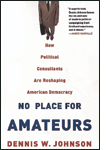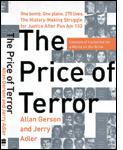|

Modern Campaigning
 America is a land of elections. We hold more elections, more frequently, than any place else today. And, according to Dennis W. Johnson, associate dean of GW’s Graduate School of Political Management, these election campaigns are no place for amateurs—which is, in fact, the title of Johnson’s new book. In No Place for Amateurs (Routledge, New York, 2001), Johnson takes readers on a brisk foray into the world of the professional political campaign. Skills, strategies, and methods are laid out as Johnson explores techniques used by professional campaign consultants. America is a land of elections. We hold more elections, more frequently, than any place else today. And, according to Dennis W. Johnson, associate dean of GW’s Graduate School of Political Management, these election campaigns are no place for amateurs—which is, in fact, the title of Johnson’s new book. In No Place for Amateurs (Routledge, New York, 2001), Johnson takes readers on a brisk foray into the world of the professional political campaign. Skills, strategies, and methods are laid out as Johnson explores techniques used by professional campaign consultants.
Johnson’s expertise, the reader should know, is well beyond academic—although currently it is certainly that as well. But political scientist Johnson has brought to the University and to this book more than a decade of experience consulting on congressional and gubernatorial campaigns, including work with top political consultants Bob Squier, Bob Shrum, Peter Hart, and James Carville.
During the past 30 years, political consultants have become increasingly visible and have created what might be called an entirely new campaign environment of pollsters, media and Web experts, and fundraisers. By contrast to the old style do-or-die of amateur campaigners, these pros are, according to Johnson, at least one or two levels of emotional detachment removed from the candidate and the campaign. Even seasoned politicos are wary. Johnson quotes former guru Lyn Nofziger. “[W]e’d still have elections, and someone would win and someone would lose, if we assassinated every one of the consultants, and the country might be better off.”
Bloody and overstated though the Nofziger solution may be, the book comprises a substantive and thought provoking look at what our political campaigns have come to. And most of us would be better equipped for Campaign 2002 if we’d spend a few hours first with No Place for Amateurs.
The Price of Liberty
 The incomprehensible events of Sept. 11, 2001, rather than being the beginning of international mass terrorist attacks on Americans, have been characterized instead as a continuation of hostilities that began in the skies over Lockerbie, Scotland, on Dec. 21, 1988. In a new book, The Price of Terror (HarperCollins, New York, 2001), GW’s Allan Gerson and Newsweek’s Jerry Adler write in moving detail of the grieving families and the lawsuits related to that bombing. The incomprehensible events of Sept. 11, 2001, rather than being the beginning of international mass terrorist attacks on Americans, have been characterized instead as a continuation of hostilities that began in the skies over Lockerbie, Scotland, on Dec. 21, 1988. In a new book, The Price of Terror (HarperCollins, New York, 2001), GW’s Allan Gerson and Newsweek’s Jerry Adler write in moving detail of the grieving families and the lawsuits related to that bombing.
Gerson is research professor of international law at GW. Adler is senior editor at Newsweek. The authors chronicle the ongoing political and legal struggles related to Pan Am 103’s crash. Full of minute, riveting details (the plastic explosive was Czech-made Semtex, molded inside a Toshiba cassette player, packed within a clothing-laden Samsonite suitcase), the details become more poignant when coupled with descriptions of how the families learn of the crash and their struggles to come to terms with their loved ones’ deaths. Compounding their grief is the fact that the families of the victims find themselves virtually ignored by official agencies.
If they were expected to fade quietly, the families shock governments and the world. They form advocacy groups and, together, take on Pan Am, the State Department, the Justice Department, the President, and ultimately Libya. With Gerson serving as attorney in many of the legal actions, the groups also help pass the Aviation Security Act of 1990, help ensure enforcement of UN Security Council sanctions against Libya, and successfully fight to amend the Foreign Sovereign Immunities Act of 1976, thus giving U.S. courts jurisdiction over foreign terrorist governments.
At the trial of two accused terrorists, one was convicted, one acquitted. But, as Gerson and Adler write in a preface written after Sept. 11, “…the American nation has been forced to consider things too long ignored. It is reaffirming the truth that eternal vigilance is the price of liberty.”
Smallpox: Dead or Alive?
 Why would a GW history professor (and sometime auto mechanic) named Elizabeth A. Fenn write a book about Variola major (the virus that causes smallpox)? In fact The New York Times found it an intriguing question too, and wrote about Fenn this past Sept. 8. Why would a GW history professor (and sometime auto mechanic) named Elizabeth A. Fenn write a book about Variola major (the virus that causes smallpox)? In fact The New York Times found it an intriguing question too, and wrote about Fenn this past Sept. 8.
But here, we want to tell you about Fenn’s book itself. For it is post-Sept. 11 America, with Anthrax and bioterrorism on every mind. Fenn’s Pox Americana:The Great Smallpox Epidemic of 1775-82 (Hill & Wang, New York, 2001) seems too apt to ignore. It also provides Revolutionary War details that many of us never knew, such as the fact that more North Americans died of smallpox than were killed by the enemy.
We do know that Europeans introduced the disease to this continent. It spread rapidly throughout the Continental Army, laying low American troops in Quebec during the British occupation of Boston. Slaves who had escaped to join the British forces in Virginia were victims of the scourge in Virginia. And at Valley Forge, only General Washington’s courageous decision to inoculate (not common practice) soldiers began slowing down the disease’s rampancy.
Fenn tells us that in 1979 the World Health Organization (WHO) certified that smallpox was eradicated from the world. But will that conquest hold? The WHO had intended only two remaining labs to retain smallpox samples: one in Russia, one in the United States, until 1999, when these supplies were to be destroyed. However, in April 1999, the United States announced it would keep its supply, due to intelligence that clandestine supplies were being kept elsewhere.
Bioterrorism fears make it doubtful—at least today—that what has been called America’s first true public health crisis has truly ended.
—Sandy Holland
|